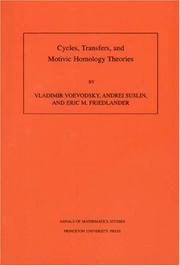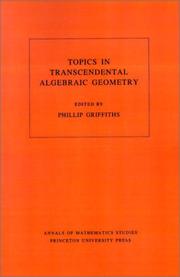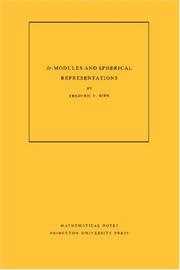| Listing 1 - 7 of 7 |
Sort by
|
Book
ISBN: 0691189633 Year: 2019 Publisher: Princeton, NJ : Princeton University Press,
Abstract | Keywords | Export | Availability | Bookmark
 Loading...
Loading...Choose an application
- Reference Manager
- EndNote
- RefWorks (Direct export to RefWorks)
This book presents the complete proof of the Bloch-Kato conjecture and several related conjectures of Beilinson and Lichtenbaum in algebraic geometry. Brought together here for the first time, these conjectures describe the structure of étale cohomology and its relation to motivic cohomology and Chow groups.Although the proof relies on the work of several people, it is credited primarily to Vladimir Voevodsky. The authors draw on a multitude of published and unpublished sources to explain the large-scale structure of Voevodsky's proof and introduce the key figures behind its development. They go on to describe the highly innovative geometric constructions of Markus Rost, including the construction of norm varieties, which play a crucial role in the proof. The book then addresses symmetric powers of motives and motivic cohomology operations.Comprehensive and self-contained, The Norm Residue Theorem in Motivic Cohomology unites various components of the proof that until now were scattered across many sources of varying accessibility, often with differing hypotheses, definitions, and language.
Homology theory. --- Cohomology theory --- Contrahomology theory --- Algebraic topology --- 5P. --- Abelian group. --- Addition. --- Additive category. --- Adjoint functors. --- Alexander Grothendieck. --- Algebraic closure. --- Algebraic cobordism. --- Algebraic cycle. --- Algebraic extension. --- Algebraic geometry. --- Algebraic topology. --- Andrei Suslin. --- Axiom. --- Characteristic class. --- Classifying space. --- Closed set. --- Codimension. --- Cofibration. --- Cohomology operation. --- Cohomology. --- Conjecture. --- Corollary. --- Diagram (category theory). --- Direct limit. --- Exact sequence. --- Factorization. --- Fibration. --- Functor. --- Galois cohomology. --- Galois extension. --- Group object. --- Homology (mathematics). --- Homotopy category. --- Homotopy. --- Hypersurface. --- Inverse function. --- Mathematical induction. --- Mathematics. --- Milnor K-theory. --- Model category. --- Module (mathematics). --- Monoid. --- Monomorphism. --- Morphism. --- Motivic cohomology. --- Natural number. --- Normal bundle. --- Open set. --- Presheaf (category theory). --- Pushout (category theory). --- Quantity. --- Quillen adjunction. --- Rational point. --- Regular representation. --- Remainder. --- Retract. --- Separable extension. --- Sheaf (mathematics). --- Smooth scheme. --- Special case. --- Subgroup. --- Summation. --- Tangent space. --- Theorem. --- Trivial representation. --- Vladimir Voevodsky. --- Weak equivalence (homotopy theory).

ISBN: 0691048142 0691048150 9786613379825 1283379821 140083712X 9780691048147 9780691048154 Year: 2011 Volume: 143 Publisher: Princeton, NJ : Princeton University Press,
Abstract | Keywords | Export | Availability | Bookmark
 Loading...
Loading...Choose an application
- Reference Manager
- EndNote
- RefWorks (Direct export to RefWorks)
The original goal that ultimately led to this volume was the construction of "motivic cohomology theory," whose existence was conjectured by A. Beilinson and S. Lichtenbaum. This is achieved in the book's fourth paper, using results of the other papers whose additional role is to contribute to our understanding of various properties of algebraic cycles. The material presented provides the foundations for the recent proof of the celebrated "Milnor Conjecture" by Vladimir Voevodsky. The theory of sheaves of relative cycles is developed in the first paper of this volume. The theory of presheaves with transfers and more specifically homotopy invariant presheaves with transfers is the main theme of the second paper. The Friedlander-Lawson moving lemma for families of algebraic cycles appears in the third paper in which a bivariant theory called bivariant cycle cohomology is constructed. The fifth and last paper in the volume gives a proof of the fact that bivariant cycle cohomology groups are canonically isomorphic (in appropriate cases) to Bloch's higher Chow groups, thereby providing a link between the authors' theory and Bloch's original approach to motivic (co-)homology.
Bundeltheorie --- Cohomology [Sheaf ] --- Faisceaux [Théorie des ] --- Sheaf cohomology --- Sheaf theory --- Sheaves (Algebraic topology) --- Sheaves [Theory of ] --- Théorie des faisceaux --- Algebraic cycles --- Homology theory --- Algebraic cycles. --- Homology theory. --- Cohomology theory --- Contrahomology theory --- Algebraic topology --- Cycles, Algebraic --- Geometry, Algebraic --- Abelian category. --- Abelian group. --- Addition. --- Additive category. --- Adjoint functors. --- Affine space. --- Affine variety. --- Alexander Grothendieck. --- Algebraic K-theory. --- Algebraic cycle. --- Algebraically closed field. --- Andrei Suslin. --- Associative property. --- Base change. --- Category of abelian groups. --- Chain complex. --- Chow group. --- Closed immersion. --- Codimension. --- Coefficient. --- Cohomology. --- Cokernel. --- Commutative property. --- Commutative ring. --- Compactification (mathematics). --- Comparison theorem. --- Computation. --- Connected component (graph theory). --- Connected space. --- Corollary. --- Diagram (category theory). --- Dimension. --- Discrete valuation ring. --- Disjoint union. --- Divisor. --- Embedding. --- Endomorphism. --- Epimorphism. --- Exact sequence. --- Existential quantification. --- Field of fractions. --- Functor. --- Generic point. --- Geometry. --- Grothendieck topology. --- Homeomorphism. --- Homogeneous coordinates. --- Homology (mathematics). --- Homomorphism. --- Homotopy category. --- Homotopy. --- Injective sheaf. --- Irreducible component. --- K-theory. --- Mathematical induction. --- Mayer–Vietoris sequence. --- Milnor K-theory. --- Monoid. --- Monoidal category. --- Monomorphism. --- Morphism of schemes. --- Morphism. --- Motivic cohomology. --- Natural transformation. --- Nisnevich topology. --- Noetherian. --- Open set. --- Pairing. --- Perfect field. --- Permutation. --- Picard group. --- Presheaf (category theory). --- Projective space. --- Projective variety. --- Proper morphism. --- Quasi-projective variety. --- Residue field. --- Resolution of singularities. --- Scientific notation. --- Sheaf (mathematics). --- Simplicial complex. --- Simplicial set. --- Singular homology. --- Smooth scheme. --- Spectral sequence. --- Subcategory. --- Subgroup. --- Summation. --- Support (mathematics). --- Tensor product. --- Theorem. --- Topology. --- Triangulated category. --- Type theory. --- Universal coefficient theorem. --- Variable (mathematics). --- Vector bundle. --- Vladimir Voevodsky. --- Zariski topology. --- Zariski's main theorem. --- 512.73 --- 512.73 Cohomology theory of algebraic varieties and schemes --- Cohomology theory of algebraic varieties and schemes

ISBN: 0691083355 0691083398 140088165X Year: 1984 Publisher: Princeton (N.J.): Princeton university press
Abstract | Keywords | Export | Availability | Bookmark
 Loading...
Loading...Choose an application
- Reference Manager
- EndNote
- RefWorks (Direct export to RefWorks)
The description for this book, Topics in Transcendental Algebraic Geometry. (AM-106), Volume 106, will be forthcoming.
Geometry, Algebraic. --- Hodge theory. --- Torelli theorem. --- Géométrie algébrique --- Théorie de Hodge --- Geometry, Algebraic --- Hodge theory --- Torelli theorem --- 512.7 --- Torelli's theorem --- Curves, Algebraic --- Jacobians --- Complex manifolds --- Differentiable manifolds --- Homology theory --- Algebraic geometry --- Geometry --- Algebraic geometry. Commutative rings and algebras --- 512.7 Algebraic geometry. Commutative rings and algebras --- Géométrie algébrique --- Théorie de Hodge --- Abelian integral. --- Algebraic curve. --- Algebraic cycle. --- Algebraic equation. --- Algebraic geometry. --- Algebraic integer. --- Algebraic structure. --- Algebraic surface. --- Arithmetic genus. --- Arithmetic group. --- Asymptotic analysis. --- Automorphism. --- Base change. --- Bilinear form. --- Bilinear map. --- Cohomology. --- Combinatorics. --- Commutative diagram. --- Compactification (mathematics). --- Complete intersection. --- Complex manifold. --- Complex number. --- Computation. --- Deformation theory. --- Degeneracy (mathematics). --- Differentiable manifold. --- Dimension (vector space). --- Divisor (algebraic geometry). --- Divisor. --- Elliptic curve. --- Elliptic surface. --- Equation. --- Exact sequence. --- Fiber bundle. --- Function (mathematics). --- Fundamental class. --- Geometric genus. --- Geometry. --- Hermitian symmetric space. --- Hodge structure. --- Homology (mathematics). --- Homomorphism. --- Homotopy. --- Hypersurface. --- Intersection form (4-manifold). --- Intersection number. --- Irreducibility (mathematics). --- Isomorphism class. --- Jacobian variety. --- K3 surface. --- Kodaira dimension. --- Kronecker's theorem. --- Kummer surface. --- Kähler manifold. --- Lie algebra bundle. --- Lie algebra. --- Linear algebra. --- Linear algebraic group. --- Line–line intersection. --- Mathematical induction. --- Mathematical proof. --- Mathematics. --- Modular arithmetic. --- Module (mathematics). --- Moduli space. --- Monodromy matrix. --- Monodromy theorem. --- Monodromy. --- Nilpotent orbit. --- Normal function. --- Open set. --- Period mapping. --- Permutation group. --- Phillip Griffiths. --- Point at infinity. --- Pole (complex analysis). --- Polynomial. --- Projective space. --- Pullback (category theory). --- Quadric. --- Regular singular point. --- Resolution of singularities. --- Riemann–Roch theorem for surfaces. --- Scientific notation. --- Set (mathematics). --- Special case. --- Spectral sequence. --- Subgroup. --- Submanifold. --- Surface of general type. --- Surjective function. --- Tangent bundle. --- Theorem. --- Topology. --- Transcendental number. --- Vector space. --- Zariski topology. --- Zariski's main theorem.

ISBN: 0691120439 0691120447 1299133258 1400837170 9780691120430 9781400837175 9780691120447 Year: 2005 Volume: no. 157 Publisher: Princeton Princeton University Press
Abstract | Keywords | Export | Availability | Bookmark
 Loading...
Loading...Choose an application
- Reference Manager
- EndNote
- RefWorks (Direct export to RefWorks)
In recent years, considerable progress has been made in studying algebraic cycles using infinitesimal methods. These methods have usually been applied to Hodge-theoretic constructions such as the cycle class and the Abel-Jacobi map. Substantial advances have also occurred in the infinitesimal theory for subvarieties of a given smooth variety, centered around the normal bundle and the obstructions coming from the normal bundle's first cohomology group. Here, Mark Green and Phillip Griffiths set forth the initial stages of an infinitesimal theory for algebraic cycles. The book aims in part to understand the geometric basis and the limitations of Spencer Bloch's beautiful formula for the tangent space to Chow groups. Bloch's formula is motivated by algebraic K-theory and involves differentials over Q. The theory developed here is characterized by the appearance of arithmetic considerations even in the local infinitesimal theory of algebraic cycles. The map from the tangent space to the Hilbert scheme to the tangent space to algebraic cycles passes through a variant of an interesting construction in commutative algebra due to Angéniol and Lejeune-Jalabert. The link between the theory given here and Bloch's formula arises from an interpretation of the Cousin flasque resolution of differentials over Q as the tangent sequence to the Gersten resolution in algebraic K-theory. The case of 0-cycles on a surface is used for illustrative purposes to avoid undue technical complications.
512.73 --- Cohomology theory of algebraic varieties and schemes --- 512.73 Cohomology theory of algebraic varieties and schemes --- Algebraic cycles. --- Hodge theory. --- Geometry, Algebraic. --- Algebraic geometry --- Geometry --- Complex manifolds --- Differentiable manifolds --- Geometry, Algebraic --- Homology theory --- Cycles, Algebraic --- Algebraic cycles --- Hodge theory --- Addition. --- Algebraic K-theory. --- Algebraic character. --- Algebraic curve. --- Algebraic cycle. --- Algebraic function. --- Algebraic geometry. --- Algebraic number. --- Algebraic surface. --- Algebraic variety. --- Analytic function. --- Approximation. --- Arithmetic. --- Chow group. --- Codimension. --- Coefficient. --- Coherent sheaf cohomology. --- Coherent sheaf. --- Cohomology. --- Cokernel. --- Combination. --- Compass-and-straightedge construction. --- Complex geometry. --- Complex number. --- Computable function. --- Conjecture. --- Coordinate system. --- Coprime integers. --- Corollary. --- Cotangent bundle. --- Diagram (category theory). --- Differential equation. --- Differential form. --- Differential geometry of surfaces. --- Dimension (vector space). --- Dimension. --- Divisor. --- Duality (mathematics). --- Elliptic function. --- Embedding. --- Equation. --- Equivalence class. --- Equivalence relation. --- Exact sequence. --- Existence theorem. --- Existential quantification. --- Fermat's theorem. --- Formal proof. --- Fourier. --- Free group. --- Functional equation. --- Generic point. --- Geometry. --- Group homomorphism. --- Hereditary property. --- Hilbert scheme. --- Homomorphism. --- Injective function. --- Integer. --- Integral curve. --- K-group. --- K-theory. --- Linear combination. --- Mathematics. --- Moduli (physics). --- Moduli space. --- Multivector. --- Natural number. --- Natural transformation. --- Neighbourhood (mathematics). --- Open problem. --- Parameter. --- Polynomial ring. --- Principal part. --- Projective variety. --- Quantity. --- Rational function. --- Rational mapping. --- Reciprocity law. --- Regular map (graph theory). --- Residue theorem. --- Root of unity. --- Scientific notation. --- Sheaf (mathematics). --- Smoothness. --- Statistical significance. --- Subgroup. --- Summation. --- Tangent space. --- Tangent vector. --- Tangent. --- Terminology. --- Tetrahedron. --- Theorem. --- Transcendental function. --- Transcendental number. --- Uniqueness theorem. --- Vector field. --- Vector space. --- Zariski topology.

ISBN: 1400862078 9781400862078 0691025177 9780691608327 9780691025179 0691025177 0691608326 9780691608327 Year: 2014 Publisher: Princeton, NJ
Abstract | Keywords | Export | Availability | Bookmark
 Loading...
Loading...Choose an application
- Reference Manager
- EndNote
- RefWorks (Direct export to RefWorks)
The theory of D-modules deals with the algebraic aspects of differential equations. These are particularly interesting on homogeneous manifolds, since the infinitesimal action of a Lie algebra consists of differential operators. Hence, it is possible to attach geometric invariants, like the support and the characteristic variety, to representations of Lie groups. By considering D-modules on flag varieties, one obtains a simple classification of all irreducible admissible representations of reductive Lie groups. On the other hand, it is natural to study the representations realized by functions on pseudo-Riemannian symmetric spaces, i.e., spherical representations. The problem is then to describe the spherical representations among all irreducible ones, and to compute their multiplicities. This is the goal of this work, achieved fairly completely at least for the discrete series representations of reductive symmetric spaces. The book provides a general introduction to the theory of D-modules on flag varieties, and it describes spherical D-modules in terms of a cohomological formula. Using microlocalization of representations, the author derives a criterion for irreducibility. The relation between multiplicities and singularities is also discussed at length.Originally published in 1990.The Princeton Legacy Library uses the latest print-on-demand technology to again make available previously out-of-print books from the distinguished backlist of Princeton University Press. These editions preserve the original texts of these important books while presenting them in durable paperback and hardcover editions. The goal of the Princeton Legacy Library is to vastly increase access to the rich scholarly heritage found in the thousands of books published by Princeton University Press since its founding in 1905.
Differentiable manifolds. --- D-modules. --- Representations of groups. --- Lie groups. --- Groups, Lie --- Lie algebras --- Symmetric spaces --- Topological groups --- Group representation (Mathematics) --- Groups, Representation theory of --- Group theory --- Modules (Algebra) --- Differential manifolds --- Manifolds (Mathematics) --- Affine space. --- Algebraic cycle. --- Algebraic element. --- Analytic function. --- Annihilator (ring theory). --- Automorphism. --- Banach space. --- Base change. --- Big O notation. --- Bijection. --- Bilinear form. --- Borel subgroup. --- Cartan subalgebra. --- Cofibration. --- Cohomology. --- Commutative diagram. --- Commutative property. --- Commutator subgroup. --- Complexification (Lie group). --- Conjugacy class. --- Coproduct. --- Coset. --- Cotangent space. --- D-module. --- Derived category. --- Diagram (category theory). --- Differential operator. --- Dimension (vector space). --- Direct image functor. --- Discrete series representation. --- Disk (mathematics). --- Dot product. --- Double coset. --- Eigenfunction. --- Eigenvalues and eigenvectors. --- Endomorphism. --- Euler operator. --- Existential quantification. --- Fibration. --- Function space. --- Functor. --- G-module. --- Gelfand pair. --- Generic point. --- Hilbert space. --- Holomorphic function. --- Homomorphism. --- Hyperfunction. --- Ideal (ring theory). --- Infinitesimal character. --- Inner automorphism. --- Invertible sheaf. --- Irreducibility (mathematics). --- Irreducible representation. --- Levi decomposition. --- Lie algebra. --- Line bundle. --- Linear algebraic group. --- Linear space (geometry). --- Manifold. --- Maximal compact subgroup. --- Maximal torus. --- Metric space. --- Module (mathematics). --- Moment map. --- Morphism. --- Noetherian ring. --- Open set. --- Presheaf (category theory). --- Principal series representation. --- Projective line. --- Projective object. --- Projective space. --- Projective variety. --- Reductive group. --- Riemannian geometry. --- Riemann–Hilbert correspondence. --- Right inverse. --- Ring (mathematics). --- Root system. --- Satake diagram. --- Sheaf (mathematics). --- Sheaf of modules. --- Special case. --- Sphere. --- Square-integrable function. --- Sub"ient. --- Subalgebra. --- Subcategory. --- Subgroup. --- Summation. --- Surjective function. --- Symmetric space. --- Symplectic geometry. --- Tensor product. --- Theorem. --- Triangular matrix. --- Vector bundle. --- Volume form. --- Weyl group.
Book
ISBN: 1400882583 Year: 2016 Publisher: Princeton, NJ : Princeton University Press,
Abstract | Keywords | Export | Availability | Bookmark
 Loading...
Loading...Choose an application
- Reference Manager
- EndNote
- RefWorks (Direct export to RefWorks)
This collection brings together influential papers by mathematicians exploring the research frontiers of topology, one of the most important developments of modern mathematics. The papers cover a wide range of topological specialties, including tools for the analysis of group actions on manifolds, calculations of algebraic K-theory, a result on analytic structures on Lie group actions, a presentation of the significance of Dirac operators in smoothing theory, a discussion of the stable topology of 4-manifolds, an answer to the famous question about symmetries of simply connected manifolds, and a fresh perspective on the topological classification of linear transformations. The contributors include A. Adem, A. H. Assadi, M. Bökstedt, S. E. Cappell, R. Charney, M. W. Davis, P. J. Eccles, M. H. Freedman, I. Hambleton, J. C. Hausmann, S. Illman, G. Katz, M. Kreck, W. Lück, I. Madsen, R. J. Milgram, J. Morava, E. K. Pedersen, V. Puppe, F. Quinn, A. Ranicki, J. L. Shaneson, D. Sullivan, P. Teichner, Z. Wang, and S. Weinberger.
Topology --- Adjunction (field theory). --- Algebraic cycle. --- Algebraic topology. --- Analytic function. --- Automorphism. --- Base change. --- Basis (linear algebra). --- Borel conjecture. --- Characteristic class. --- Circle group. --- Classifying space. --- Cobordism. --- Codimension. --- Cohomology ring. --- Cohomology. --- Combinatorial group theory. --- Commutative diagram. --- Commutative property. --- Compactification (mathematics). --- Coxeter group. --- Cyclic group. --- Cyclic homology. --- Diagram (category theory). --- Diffeomorphism. --- Differentiable manifold. --- Differential topology. --- Dimension (vector space). --- Dirac operator. --- Discrete valuation ring. --- Divisor (algebraic geometry). --- Elliptic operator. --- Equivariant K-theory. --- Equivariant cohomology. --- Equivariant map. --- Exterior (topology). --- Exterior algebra. --- Fiber bundle. --- Fibration. --- Fundamental group. --- Gauss map. --- Geometrization conjecture. --- Group algebra. --- H-cobordism. --- Homeomorphism. --- Homotopy fiber. --- Homotopy group. --- Homotopy. --- Hopf algebra. --- Identity matrix. --- Inclusion map. --- Intersection form (4-manifold). --- Isomorphism class. --- J-homomorphism. --- Knot theory. --- L-theory. --- Lens space. --- Lie algebra. --- Lie group. --- Linear algebra. --- Mapping cone (homological algebra). --- Mapping cone (topology). --- Marriage theorem. --- Metric space. --- Moduli space. --- Motivic cohomology. --- Neighbourhood (mathematics). --- Operator norm. --- Pushout (category theory). --- Quasi-isometry. --- Quotient space (topology). --- Real projective space. --- Regularization (mathematics). --- Representation theory. --- Riemann surface. --- Riemannian manifold. --- Set (mathematics). --- Sheaf (mathematics). --- Sign (mathematics). --- Simplicial complex. --- Stable homotopy theory. --- Subgroup. --- Submanifold. --- Submersion (mathematics). --- Subset. --- Support (mathematics). --- Sylow theorems. --- Tangent space. --- Theorem. --- Topological K-theory. --- Topological group. --- Topological manifold. --- Topological space. --- Topology. --- Torsion sheaf. --- Transversality (mathematics). --- Unification (computer science). --- Vector bundle. --- Whitehead torsion. --- Zariski topology. --- Zorn's lemma.

ISBN: 0691082383 1400883989 Year: 1980 Publisher: Princeton (N.J.): Princeton university press
Abstract | Keywords | Export | Availability | Bookmark
 Loading...
Loading...Choose an application
- Reference Manager
- EndNote
- RefWorks (Direct export to RefWorks)
One of the most important mathematical achievements of the past several decades has been A. Grothendieck's work on algebraic geometry. In the early 1960s, he and M. Artin introduced étale cohomology in order to extend the methods of sheaf-theoretic cohomology from complex varieties to more general schemes. This work found many applications, not only in algebraic geometry, but also in several different branches of number theory and in the representation theory of finite and p-adic groups. Yet until now, the work has been available only in the original massive and difficult papers. In order to provide an accessible introduction to étale cohomology, J. S. Milne offers this more elementary account covering the essential features of the theory. The author begins with a review of the basic properties of flat and étale morphisms and of the algebraic fundamental group. The next two chapters concern the basic theory of étale sheaves and elementary étale cohomology, and are followed by an application of the cohomology to the study of the Brauer group. After a detailed analysis of the cohomology of curves and surfaces, Professor Milne proves the fundamental theorems in étale cohomology -- those of base change, purity, Poincaré duality, and the Lefschetz trace formula. He then applies these theorems to show the rationality of some very general L-series.Originally published in 1980.The Princeton Legacy Library uses the latest print-on-demand technology to again make available previously out-of-print books from the distinguished backlist of Princeton University Press. These editions preserve the original texts of these important books while presenting them in durable paperback and hardcover editions. The goal of the Princeton Legacy Library is to vastly increase access to the rich scholarly heritage found in the thousands of books published by Princeton University Press since its founding in 1905.
Ordered algebraic structures --- 512.73 --- 512.66 --- Geometry, Algebraic --- Homology theory --- Sheaf theory --- Cohomology, Sheaf --- Sheaf cohomology --- Sheaves, Theory of --- Sheaves (Algebraic topology) --- Algebraic topology --- Cohomology theory --- Contrahomology theory --- Algebraic geometry --- Geometry --- Cohomology theory of algebraic varieties and schemes --- Homological algebra --- Geometry, Algebraic. --- Homology theory. --- Sheaf theory. --- 512.66 Homological algebra --- 512.73 Cohomology theory of algebraic varieties and schemes --- Abelian category. --- Abelian group. --- Adjoint functors. --- Affine variety. --- Alexander Grothendieck. --- Algebraic closure. --- Algebraic cycle. --- Algebraic equation. --- Algebraic space. --- Algebraically closed field. --- Artinian. --- Automorphism. --- Base change. --- Brauer group. --- CW complex. --- Cardinal number. --- Category of sets. --- Central simple algebra. --- Chow's lemma. --- Closed immersion. --- Codimension. --- Cohomology ring. --- Cohomology. --- Cokernel. --- Commutative diagram. --- Complex number. --- Dedekind domain. --- Derived category. --- Diagram (category theory). --- Direct limit. --- Discrete valuation ring. --- Divisor. --- Epimorphism. --- Equivalence class. --- Existential quantification. --- Fibration. --- Field of fractions. --- Fine topology (potential theory). --- Finite field. --- Finite morphism. --- Flat morphism. --- Functor. --- Fundamental class. --- Fundamental group. --- G-module. --- Galois cohomology. --- Galois extension. --- Galois group. --- Generic point. --- Group scheme. --- Gysin sequence. --- Henselian ring. --- Identity element. --- Inclusion map. --- Integral domain. --- Intersection (set theory). --- Inverse limit. --- Invertible sheaf. --- Isomorphism class. --- Lefschetz pencil. --- Local ring. --- Maximal ideal. --- Module (mathematics). --- Morphism of schemes. --- Morphism. --- Noetherian. --- Open set. --- Power series. --- Presheaf (category theory). --- Prime ideal. --- Prime number. --- Principal homogeneous space. --- Profinite group. --- Projection (mathematics). --- Projective variety. --- Quasi-compact morphism. --- Residue field. --- Riemann surface. --- Sheaf (mathematics). --- Sheaf of modules. --- Special case. --- Spectral sequence. --- Stein factorization. --- Subalgebra. --- Subcategory. --- Subgroup. --- Subring. --- Subset. --- Surjective function. --- Tangent space. --- Theorem. --- Topological space. --- Topology. --- Torsion sheaf. --- Torsor (algebraic geometry). --- Vector bundle. --- Weil conjecture. --- Yoneda lemma. --- Zariski topology. --- Zariski's main theorem. --- Geometrie algebrique --- Cohomologie
| Listing 1 - 7 of 7 |
Sort by
|

 Search
Search Feedback
Feedback About UniCat
About UniCat  Help
Help News
News